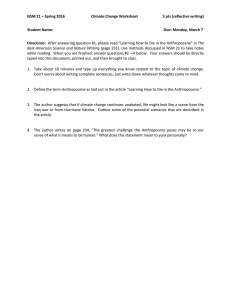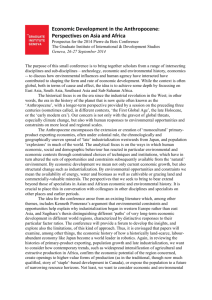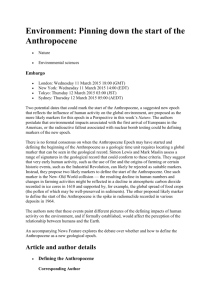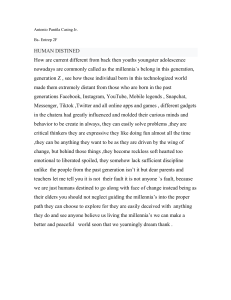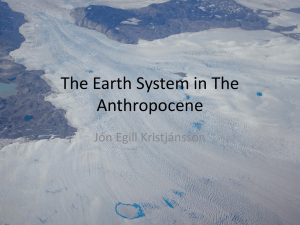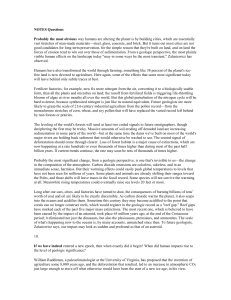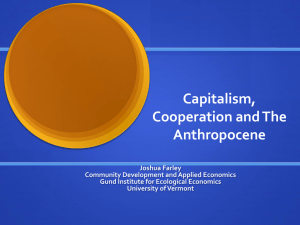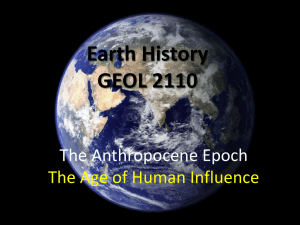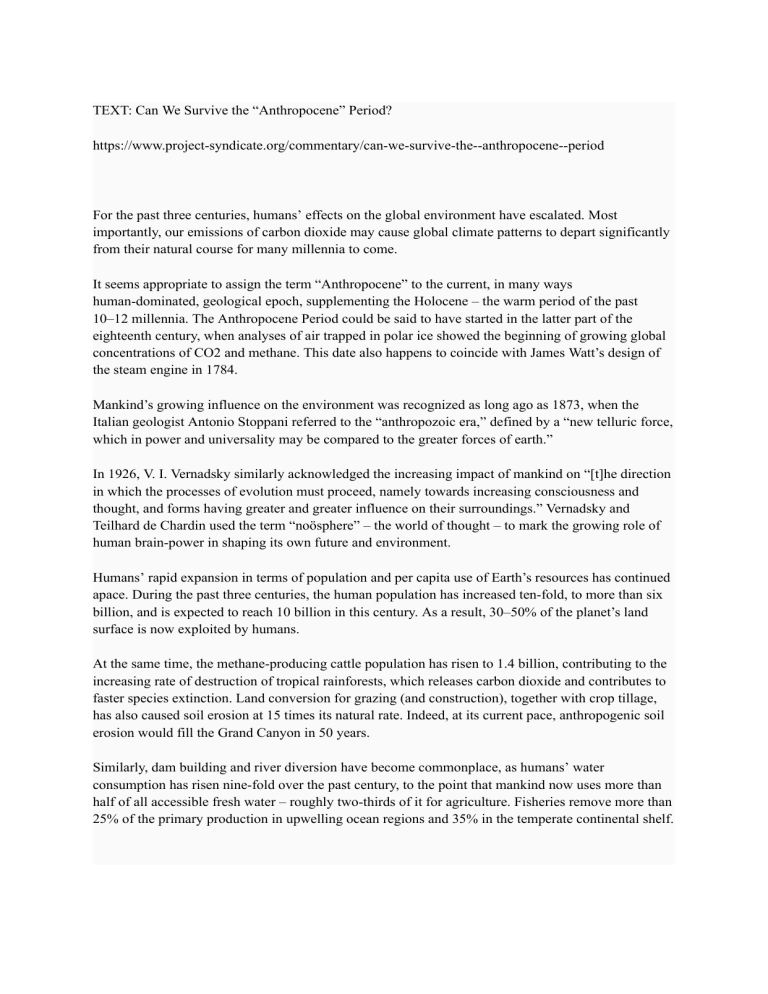
TEXT: Can We Survive the “Anthropocene” Period? https://www.project-syndicate.org/commentary/can-we-survive-the--anthropocene--period For the past three centuries, humans’ effects on the global environment have escalated. Most importantly, our emissions of carbon dioxide may cause global climate patterns to depart significantly from their natural course for many millennia to come. It seems appropriate to assign the term “Anthropocene” to the current, in many ways human-dominated, geological epoch, supplementing the Holocene – the warm period of the past 10–12 millennia. The Anthropocene Period could be said to have started in the latter part of the eighteenth century, when analyses of air trapped in polar ice showed the beginning of growing global concentrations of CO2 and methane. This date also happens to coincide with James Watt’s design of the steam engine in 1784. Mankind’s growing influence on the environment was recognized as long ago as 1873, when the Italian geologist Antonio Stoppani referred to the “anthropozoic era,” defined by a “new telluric force, which in power and universality may be compared to the greater forces of earth.” In 1926, V. I. Vernadsky similarly acknowledged the increasing impact of mankind on “[t]he direction in which the processes of evolution must proceed, namely towards increasing consciousness and thought, and forms having greater and greater influence on their surroundings.” Vernadsky and Teilhard de Chardin used the term “noösphere” – the world of thought – to mark the growing role of human brain-power in shaping its own future and environment. Humans’ rapid expansion in terms of population and per capita use of Earth’s resources has continued apace. During the past three centuries, the human population has increased ten-fold, to more than six billion, and is expected to reach 10 billion in this century. As a result, 30–50% of the planet’s land surface is now exploited by humans. At the same time, the methane-producing cattle population has risen to 1.4 billion, contributing to the increasing rate of destruction of tropical rainforests, which releases carbon dioxide and contributes to faster species extinction. Land conversion for grazing (and construction), together with crop tillage, has also caused soil erosion at 15 times its natural rate. Indeed, at its current pace, anthropogenic soil erosion would fill the Grand Canyon in 50 years. Similarly, dam building and river diversion have become commonplace, as humans’ water consumption has risen nine-fold over the past century, to the point that mankind now uses more than half of all accessible fresh water – roughly two-thirds of it for agriculture. Fisheries remove more than 25% of the primary production in upwelling ocean regions and 35% in the temperate continental shelf. Moreover, energy use has grown 16-fold during the twentieth century, causing 160 million tons of atmospheric sulfur-dioxide emissions per year – more than twice the total of natural emissions. Likewise, more nitrogen fertilizer is applied in agriculture than is fixed naturally in all terrestrial ecosystems, and nitric-oxide production from the burning of fossil fuels and biomass also surpasses natural emissions. At the same time, of course, human consumption of fossil fuels, together with our agricultural activities, have caused substantial increases in concentrations of “greenhouse” gases – CO2 by 30% and methane by more than 100%. Indeed, these concentrations are higher than at any point in the past 400 millennia, with more growth to follow, because so far these effects have largely been caused by only 25% of the world population. The consequences are numerous and profound: acid precipitation, photochemical “smog” and global warming, among others. Hence, according to the latest estimates by the Intergovernmental Panel on Climate Change (IPCC), Earth will warm by 1.4 -- 5.8 °C during this century. Many toxic substances are released into the environment, even some that are not toxic but nonetheless are highly damaging – for example, the chlorofluorocarbons that caused the Antarctic ozone hole (and which are now regulated). Things could have become much worse: the ozone-destroying properties of halogens have been studied since the mid-1970’s. If it had turned out that chlorine behave chemically like bromine, the ozone hole would by then have been a global, year-round phenomenon, not just an event of the Antarctic spring. More by luck than by wisdom, this catastrophic situation did not develop. Unless there is a global catastrophe – a meteorite impact, a world war, or a pandemic – mankind will remain a major environmental force for many millennia. As a result, scientists and engineers face a daunting task during the Anthropocene era: to guide us towards environmentally sustainable management. This will require appropriate human behavior at all levels, and may well involve internationally accepted, large-scale geo-engineering projects to “optimize” climate. At this stage, however, we are still largely treading on terra incognita . NOTES: Title: Anthropocene and Its Impact on the Global Environment Introduction - Over the past three centuries, human activities have significantly escalated their effects on the global environment. One of the most pressing issues is the emission of carbon dioxide (CO2), which has the potential to disrupt global climate patterns for millennia. The Term "Anthropocene" - The term "Anthropocene" is suggested to describe the current geological epoch, dominated by human influence. It supplements the Holocene, a warm period that has lasted for the past 10-12 millennia. The Anthropocene is believed to have started in the late 18th century, marked by the increase in global CO2 and methane concentrations. James Watt's design of the steam engine in 1784 coincides with the beginning of the Anthropocene. Early Recognition of Human Impact ● ● ● In 1873, Italian geologist Antonio Stoppani referred to the "anthropozoic era," highlighting the new telluric force exerted by humans. In 1926, V. I. Vernadsky acknowledged the growing influence of mankind on evolution and the environment. The term "noösphere" was introduced to signify the role of human intelligence in shaping the future and environment. Human Population and Resource Utilization - The global human population has increased tenfold in the past three centuries, exceeding six billion and expected to reach ten billion in the 21st century. Humans exploit 30-50% of the planet's land surface. The rise in cattle population contributes to the destruction of tropical rainforests, releasing CO2 and causing species extinction. Land conversion, grazing, and crop tillage result in soil erosion at 15 times the natural rate. Impact on Water Resources - Dam construction and river diversion are common practices. Human water consumption has increased ninefold in the last century, with over half of all accessible fresh water being used. Two-thirds of this water consumption is for agriculture. Energy Use and Pollution - Energy consumption has grown 16-fold during the 20th century. This leads to the release of 160 million tons of atmospheric sulfur dioxide annually. Nitrogen fertilizer use in agriculture surpasses natural levels, and nitric oxide emissions from fossil fuel and biomass burning also exceed natural levels. Greenhouse Gas Emissions - The consumption of fossil fuels and agricultural activities have led to a significant increase in "greenhouse" gases, with CO2 up by 30% and methane up by more than 100%. Concentrations of these gases are higher than any point in the past 400 millennia. Environmental Consequences - The consequences of these actions include acid precipitation, photochemical "smog," and global warming. The Intergovernmental Panel on Climate Change (IPCC) estimates Earth will warm by 1.4 -5.8°C during this century. Pollution and Regulation - Toxic substances are released into the environment, including chlorofluorocarbons, which caused the Antarctic ozone hole and are now regulated. Averted Catastrophe - The ozone-destroying properties of halogens have been studied since the mid-1970s. If chlorine had behaved chemically like bromine, the ozone hole would have been a global, year-round phenomenon. The Future of Anthropocene - Unless there is a global catastrophe, such as a meteorite impact, world war, or pandemic, humans will remain a major environmental force for millennia. Scientists and engineers must guide us toward environmentally sustainable management, potentially involving large-scale geo-engineering projects. The Anthropocene presents an uncertain future, and there is much more to discover and understand. The Limits to Growth: A Report to The Club of Rome (1972): - - - - - Five major global trends are examined: accelerating industrialization, rapid population growth, widespread malnutrition, depletion of nonrenewable resources, and a deteriorating environment. The model is acknowledged as imperfect and oversimplified but is presented for the purpose of providing insights to decision-makers. Conclusions include the prediction that if current growth trends continue, the planet will reach its limits within the next century, leading to a sudden and uncontrollable decline in both population and industrial capacity. It is possible to alter these growth trends and achieve a sustainable future where everyone's basic needs are met and each individual has the opportunity to realize their potential. The text emphasizes that exponential growth in various aspects of society is a common process but becomes complex when multiple quantities grow simultaneously. System dynamics, a method to understand complex systems, is introduced, emphasizing the importance of examining the interrelationships and feedback loops within a system. The behavior mode of the system is characterized by overshoot and collapse, often due to nonrenewable resource depletion and environmental degradation. The text considers the potential impact of technological advancements, but even optimistic scenarios do not prevent the eventual end of growth, typically by the year 2100. The importance of considering social side-effects of new technologies and the slow pace of political and social change is discussed. The text raises the question of whether society should limit growth voluntarily or continue growing until natural limits force a change, highlighting the need for conscious choices regarding growth and its implications. It emphasizes the belief that technology can be beneficial when combined with deliberate checks on growth, and the need for responsible progress rather than blind acceptance. Calls for society to evaluate technological advances. Proposes three key questions for assessing new technology. - Side-effects, both physical and social. - Necessary social changes and time to achieve them. - Consequences of removing natural growth limits. Recent rapid population growth due to lower mortality rates. Positive birth-rate loop has weakened the negative feedback loop. Two ways to restore balance: decrease birth rate or increase death rate. Stabilizing population alone is insufficient to prevent collapse; the same goes for capital. Suggests controlling both positive feedback loops simultaneously. Stabilizing population in 1975 and industrial capital growth in 1985. Discusses combining technological and value changes to reduce growth tendencies. Describes the "equilibrium" state as a stable, balanced condition. Population and capital stocks remain constant. Details the minimum requirements for equilibrium: - Constant population and capital size. - Minimal input and output rates. - Levels of capital and population can be adjusted as needed. Emphasizes that equilibrium doesn't mean stagnation. Corporations can expand or fail. Technological advance is necessary and welcome. - Lists activities that can flourish: education, art, research, etc. Acknowledges there will still be pressures. Equilibrium involves trading certain human freedoms for others. Hints at the emergence of new freedoms like universal education and freedom from hunger and poverty. Transitioning from growth to equilibrium is challenging but not impossible. Calls for gradual changes rather than abrupt shifts. Urges discussion, analysis, and new ideas from various sources. Emphasizes the importance of addressing growth issues urgently. Calls for a realistic long-term goal and human commitment to it. Suggests that humanity possesses the knowledge and resources to create a sustainable society. Stresses that without a long-term goal, short-term concerns will drive the world system toward its limits. Urges humanity to begin a controlled, orderly transition from growth to global equilibrium.
